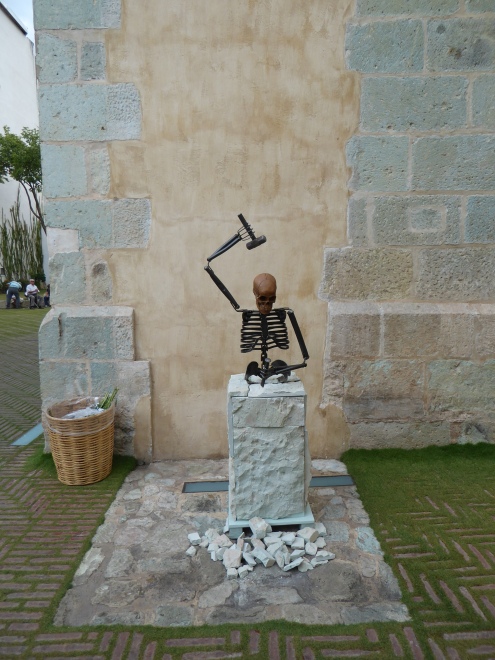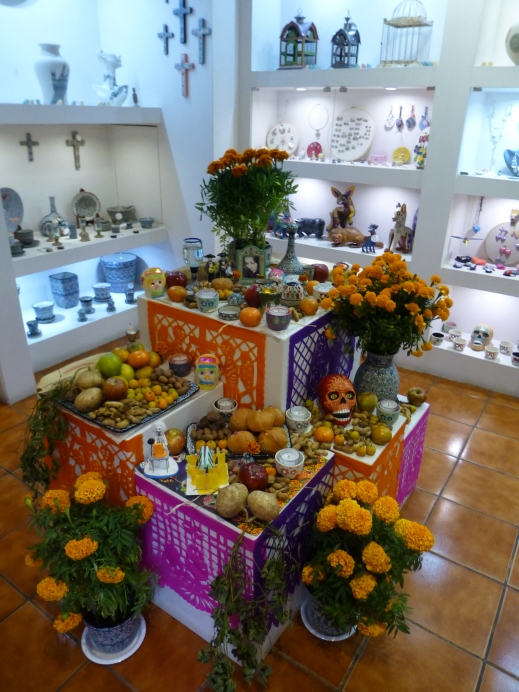I read a quote recently about the Mexicans relationship with and love of all things death related:
“The Mexicans, familiar with death, jokes about it, caresses it, sleeps with it, it’s one if his favourite toys and his most steadfast love”
How very true…
There’s so much to talk about when it comes to this celebration, so I’ve decided to write two separate posts. The first one will focus on the traditions and roots behind Day of the Dead and the other will focus what we got up to over the festivities.
The lead up started weeks ago; elaborately dressed skeletons appearing in shop doorways, day of the dead flags popping up here there and everywhere and markets full of candy skulls! Closer to the date, the streets became lined with people selling Cempazuchitl (marigolds), and the beautiful cerise bunches of Cocksomb.
Day of the Dead has been celebrated here in Mexico for hundreds of years (traditionally only in the South), and can even be traced back to the Aztecs. Originally, it was celebrated in line the summer solstice, however, when the Spanish came over they moved the celebration to coincide with All Souls Day. Over recent years the celebration has become more and more well known, people in America and England now seem to be enamoured by the celebration. I’ve seen countless photos across social media of people painting their faces like the infamous Calavera Catrina (see final paragraph for more info). Not to mention the latest James Bond being filmed in Mexico City during the festival!
Since passing through Mexico 4 years ago, I’ve been fascinated by the festival. For me, the fact that the Mexicans celebrate the life of those lost, rather than mourning death, is an inspiring way to accept death. When my parents came to visit I was discussing the festival with my Mum, who had assumed Day of the Death was a more sinister affair (similar to Halloween), especially with all of the skulls and skeletons etc. However, after explaining in more detail, my Mum also agreed that it’s a rather beautiful way to celebrate those we have lost.

My parents also came to understand that the skull isn’t a sinister symbol amongst Mexican’s, you will see them EVERYWHERE you go here. The frequent use of the skull demonstrates the Mexican’s acceptance of death, and shows that it is nothing to fear. They make the skulls beautiful with glitter and colours, to show that it’s something to be celebrated.

For those that don’t know the ins- and-outs of the festival, I’ll briefly explain what my understanding is here:
Day of the Dead actually spans over a few days; starting on the 31st October with the Dia de los Angelitos (Day of the Angels). From 3pm on the 31st October, until 3pm on the 1st November, the littles souls can return to their loved ones on earth. Then, from 3pm on the 1st November until 3pm on the 2nd November, it’s Dia de los Muertos, when all the other souls can return home.
Those who have lost loved one build altars to help guide them home, usually with 2 levels (signifying earth and heaven), although in the past they had 3 levels which included the underworld. The altars are decorated beautifully; people often spend a lot of money to build their altars to pay respect their deceased. There are numerous elements to the altar:
- Candles – to guide the spirits homes.
- Marigolds – symbolise death, and their fragrance helps to guide the dead back to earth, petals are often sprinkled up to altar, also as a guide.
- Incense – usually an intense and heady type of incense called copal, which is again used to guide the spirits home.
- Salt – to give the spirits energy after a long journey and to represent the continuance of life.
- Water – because the souls will be thirsty after their long journey home.
- Photos of the deceased – usually at the top of the altar in the centre.
- Pan de Muerto – this symbolises the deceased, you will find it everywhere in the weeks leading to the festival (bread of the dead).
- Sugar skulls – the skulls symbolise the afterlife and are often found on the altar or they can be given as gifts during the festival.
- Food – usually the favourite food of the deceased, typically fresh fruit, mole, tomales, tortillas etc.
- Toys – for the angels. It’s common to find toys and games on the altar for the child to play with when they return.

On the day, families will go to the cemetery and sit by the graves until 3pm the next day, when they can then share and eat the food on the altar. Taking anything from the altar before this time is disrespectful to the dead, so it’s pretty common to see people sat by the graves with a grill going to cook some food throughout the night and to heat up hot chocolate.
The families gather by the graves and tell stories of their loved ones, celebrate their lives and be thankful for the time they had with them. It’s a truly beautiful site to see different generations gathered together by the graves. But it was also deeply moving when we saw someone sat alone by a beautifully decorated grave, deep in thought.
Finally, I couldn’t finish this post without mentioning Catrina! The beautifully elegant skeleton who has become the symbol of Day of the Dead, and the style in which most people paint their faces for Halloween! The Calavera Catrina (Elegant Skull) was a zinc etching by famous cartoonist, José Guadalupe Posada, around 1910. It shows a skull dressed with an elegant hat, similar to those worn by the upper-class Europeans at the time. It was more of a satirical etching, as native Mexican’s were aspiring to adopt to European lifestyle. Catrina became significantly more popular when Diego Rivera recreated her in one of her murals in 1948.








Really enjoying your tales from Oaxaca.
LikeLike